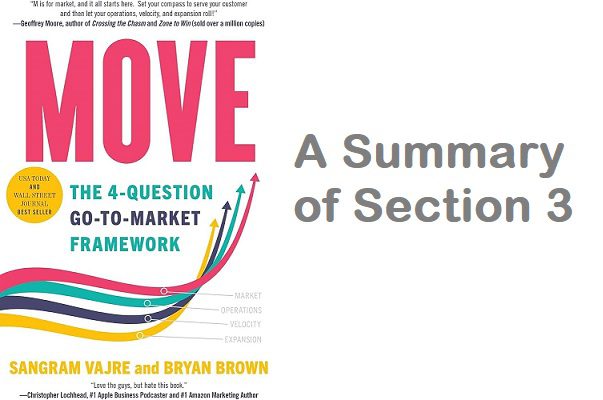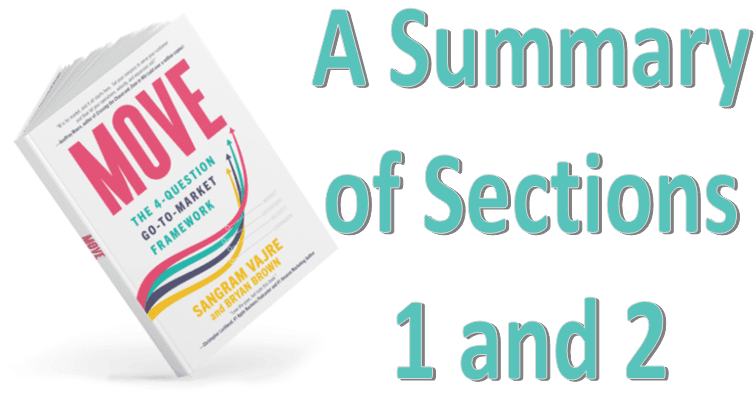“MOVE: The 4-Question Go-to-Market Framework” – A Summary of Section 3

Summary
This post details some of the takeaways from the third section of Sangram Vajre and Bryan Brown's "MOVE Framework", teaching business leaders the questions they need to ask when reimagining scaling their go-to-market initiatives. Section 3 of the book dives into the MOVE framework, the "how" and the following blog post (next month), will cover the remaining two sections.
By Brenna Lofquist, Senior Marketing Consultant / Client Services Operations at Heinz Marketing
Before you read any further, if you haven’t already read the preceding post, “MOVE: The 4-Question Go-to-Market Framework” – A Summary of Sections 1 and 2, by my colleague Sarah Threet, I recommend you do that first! After you’ve read the first post, you’re good to go to continue.
In the first post you’ll learn about some of our values at Heinz Marketing and hence why we started a book club. The short version is we want to keep learning and improving to better serve our clients.
“MOVE: The 4-Question Go-to-Market Framework” by Sangram Vajre and Bryan Brown was the first book on our tour and I’m here to provide a summary of section 3. There’s too much great information to cover the rest of the sections in one post. I highly recommend you get the book though because while this might seem like a lot of information, there’s still more in the book.
The MOVE Framework
Section 1 and 2 laid the foundation for GTM transformation now it’s time to get into the how. The MOVE framework is defined as:
- Market: Who should we market to?
- Operations: What do we need to operate effectively?
- Velocity: When we can we scale our business
- Expansion: Where can we grow the most?
Pretty simple right? That’s the point. This doesn’t need to be a complicated foundation and that’s why we really liked what Sangram and Bryan developed. These four questions can also be thought of as “who, what, when, and where”. It’s important to note that this process is cyclical. In the book they say to think of it as “a giant wheel that keeps turning, moving you forward from market to market, and the spokes of the wheel are the four questions.”
Let’s dive into each of these questions a little more. And another note, while I’m going to cover each question, there is so much more information in the book – so check it out!
Market: Who should we market to?
The relevancy of your target market is what’s going to drive business outcomes, so focus there. You should not be addressing your entire market in your GTM strategy. To get to your relevant market you need to gather (better) data about your customers. The goal here is to discover where you should expand in order to better serve your customers.
To take this a step further, you need to categorize the accounts in your target market so you know where to focus. Included are the data points you should gather to define each category.
- Total Addressable Market (TAM): These are all of the customers you could pursue over the next five to ten years. TAM is often used to describe large market opportunities, but it lacks prioritization and actionability.
- Firmographic and technographic data
- Total Relevant Marketing (TRM): These are the customers you should pursue now because they’re your best-fit target accounts, and they present the highest priority opportunities today. Bear in mind, your TRM will grow in size over time as you win more customers and scale your business.
- ICP attributes and psychographic data
- Intent Accounts: These are companies that have shown intent toward purchasing your product or a product like yours. Think of them as being “in market” to some degree or another. You should be pursuing them with your outbound marketing and sales efforts, even if they’re not in your pipeline yet.
- Engagement data, Hiring activity, Research (consumption habits or trends), Relationship (interactions with your employees)
- In-Pipeline Accounts: These companies have started taking actions that suggest they are in the market to purchase a product like yours, and your sales team is already interacting with them.
The goal is to progress target accounts toward becoming in-pipeline accounts based on relevancy and their readiness to buy (intent data).
Operations: What do we need to operate effectively?
Operations can mean a number of things depending on who you’re talking to. In the context of this book Operations is RevOps. So, what is the goal of RevOps? To discern the truth of the numbers over and above the mere opinions of people so the business can make accurate decisions.
Operations is the brain of the framework and consists of repeatable processes, data, your systems and tech stack, and metrics.
The book goes into detail about how to develop an org structure if RevOps is not a current function of yours. If that’s something you’re interested in, I recommend you buy the book. There’s some great visual examples!
The elements listed above will remain consistent no matter where you are in your GTM journey, however the pieces of each will depend on where you are. Here’s what it might look like (Reference the first summary of the book if you forget the GTM maturity curve):
Ideation (Problem-Market Fit)
- Metrics by function
- Tech could include: CRM, MAP conversion tracking, CMS, sales automation and contact data
Transition (Product-Market Fit)
- Metrics by account segment
- Tech could include: Ideation tech plus ABM platform, intent data, intelligence data, multichannel delivery, sales enablement and automated training, and customer service automation
Execution (Platform-Market Fit)
- Metrics by customer cohorts
- Tech could include: Execution tech plus customer data platform, data stack with AI/ML modeling, customer experience management, full journey orchestration, and sales forecasting
These elements are what you need to operate effectively no matter what your industry or niche.
Velocity: When can we scale our business?
Velocity is all about timing. There’s the old saying “time kills all great ideas”, so if you don’t know when to make your next move, you might miss the opportunity. On the flip side, if you enter too early you can crash and burn.
There are two velocity ramps that you need to create: the people ramp and the enablement ramp.
People Ramp
Determines how fast your people get things done and achieve success in their individual roles. People ramp also tells you how quickly you can get customers to see the value of a product.
Enablement Ramp
How to enable your high-performing revenue team to be successful. This includes all teams (marketing, sales, and customer success).
Bottom line teams need to functioning in alignment and at the same pace for this to work. They bring this all together in the book by saying “GTM is the vehicle for delivering your company’s mission and vision to customers, and your people become your brand ambassadors”. So if you don’t ramp effectively, then you’re going to miss opportunities because you lack the people to take advantage of them.
To bring it back to the GTM Maturity Curve, your ramps will change depending on where you are in the curve. For example, in the Ideation Stage, you focus on “putting out fires”. You can’t predict them yet. Whereas in the Execution Stage, you focus on improving the customer experience.
I like this framework because it was developed intentionally to flow. You figure out your marketing, then you get your operations in place, now you have the confidence to move at velocity. Last comes expansion!
Expansion: Where can we grow the most?
Expansion simply put is about figuring out where your next best opportunity lies. As defined in the book, there are three ways to expand.
Expansion with sales
Typically starts with direct sales and then you might add referral partners, then build out channel partners, etc. You’re incrementally building capacity outside the walls of your company.
Expansion with coverage
Expanding into a different market, vertical, or even upmarket or down-market.
Expansion with solutions
Increasing the solutions you offer. For example, a single-product point solution to a multiple-product platform solution.
No matter which way you decide to expand, the MOVE framework remains consistent. You need to develop each spoke of the wheel for a smooth ride!
To summarize
After going through each component of the MOVE framework, you should be well on your way to understanding where you sit in the GTM Maturity Curve and what you need to do to get to the next level. Remember it goes back to “who, what, when, where” – don’t overcomplicate it!
We highly recommend checking out this book, and you can expect a summary of the remaining two sections in our blog next month!






